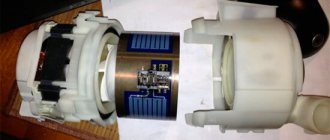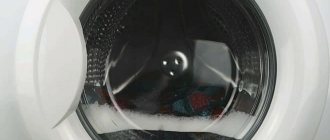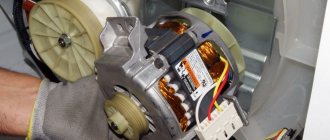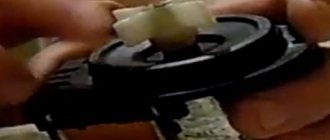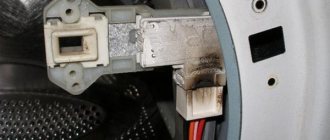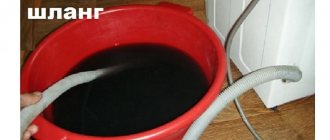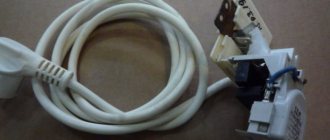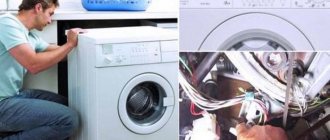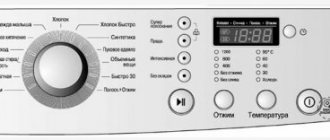One of the most unpleasant breakdowns is when the washing machine does not heat the water. Here we are talking not only about the difficulty of identifying the cause, but also about the fact that the fact of a breakdown is not immediately detected. As a rule, suspicions arise when the quality of the wash decreases. And you can finally be sure as follows:
- Start the washing mode, which features a high heating temperature.
- 10-15 minutes after starting, touch the glass of the loading hatch with your hand.
- If the glass is cold, it means that the water is not heated.
Practice shows that there are several reasons why the washing machine does not heat the water:
- Problems with the heating element.
- Failure of the heating element - diagnostic features.
- Reduced efficiency of the heating element due to a large layer of limescale.
- Failure or failure of the temperature sensor.
- Failure or failure of the pressure switch - monitors the water filling level of the tank.
- Control module failure.
Some of these breakdowns, for example, replacing the heating element, can be fixed on your own, provided that you are confident in your own abilities and are able to assemble the washing machine after disassembling it. Other breakdowns, usually associated with the control module, can only be corrected by professionals with the appropriate education and special tools.
Problems with the heating element
The first and most likely reason why the washing machine does not heat the water is the failure of the heater - the heating element. To check the part, it must be removed from the washing machine. This is done as follows:
- The back panel of the washing machine is removed. To do this, you need to unscrew all the bolts located around the perimeter of the panel.
- On some models, in order to get to the bolts located on top, you need to additionally remove the cover.
- The power wires are disconnected from the terminals.
- The lock nut is unscrewed and the heating element is removed from the mounting hole.
element is located at the rear.
The heater is located at the rear near the electric motor pulley.
For some models of washing machines, the heating element is located at the front. To access it, you must follow these steps:
- Remove the top cover - it is secured at the back with 2 bolts.
- Remove the dispenser by pressing the stopper inside.
- Unscrew the screws holding the control panel and, without damaging the wires, set it aside.
- Fold back the cuff.
- Dismantle the UBL - hatch blocking device.
- Remove the front panel of the case.
This is a rather tedious and complicated procedure. So if you are not confident in your abilities, it is better to take the washing machine to a workshop.
The heating element is located in the front
Testing the heating element
After removing the heating element, you can begin to diagnose it; a multimeter is needed to check. The tester can diagnose the following problems: open circuit, breakdown and current leakage. Let's look at diagnostic methods and working with a multimeter tester in more detail:
- To the cliff. The tester is in resistance measurement mode. We apply the probes to the contacts of the heating element. If there is an open circuit, then all tester indicators will be in their original position.
- For a breakdown. We change the tester settings to a parameter of 200 megaohms. We apply one probe to the contact, the second to the body. If there is no reaction, then there is no “cold” breakdown. However, it is advisable to check the heating element when heating. To do this, you need to use a regular power cord with a plug. We connect the wires to the contacts of the heating element, and then plug it into an outlet for 3-5 seconds. After this, we repeat the measurements. If any numbers appear on the tester display, it means there is a breakdown of the dielectric shell.
Testing the heating element for breakdown
- For current leakage. To check the heating element for current leakage, you must first calculate the standard value. To do this, divide the heater power, indicated directly on the body or in the technical documentation of the washing machine, by the mains voltage constant of 220 V. For example, if the heating element has a power of 1900 W, then the calculated electric current will be 8A.
Testing the heating element for current leakage
In order to check it, you need to install a tester at 20 A. Then connect one probe with a clamp to the heating element. The power cord wire is connected to the second terminal. We plug the power cord into the outlet, and connect the remaining probe to the second wire. The tester monitor should show the calculated value.
Why carry out so many checks, and what conclusion can be drawn from their results? First of all, comprehensive testing helps rule out other reasons why the washing machine is not heating. In the first two cases, the heating element must only be replaced. If there is a current leak, repairs are possible, but they can only be carried out in a service center. Although in most cases it is more economically feasible to purchase a new heating element.
Cleaning scale on heating elements
Scale on heating elements is one of the main reasons for reduced washing efficiency, especially in areas with hard carbonate water. In addition to significantly increasing the energy consumption of the washing machine, it can lead to other, more serious problems and breakdowns. Pieces of scale can clog the drain hose, pierce the pipes or tank wall, or jam the drum. Descaling can be done in several ways.
Scale on the heating element
Constantly use specialized cleaning products such as Calgon. However, as practice has shown, even with the use of any means, scale still forms, although much more slowly.
For one-time cleaning, you can use citric acid. Add 150-200 g of product to the powder tray. Then select the longest washing program with a temperature of at least 60°C, but without spinning. If there is a significant amount of scale, this cleaning can be done several times in a row, but in an empty washing machine. Breakaway pieces of scale are cleaned out from under the rubber cuff.
The most effective way is to clean the extracted heating element in special concentrated products. They cannot be used in a washing machine, as there is a high risk of damage to rubber parts: seals, cuffs, pipes, etc.
Cleaning scale on heating elements
To clean, remove the heating element from the washing machine, as described earlier. Hot water is poured into a two-liter plastic bottle with the top cut off or a plastic bucket and an anti-scale agent is added, which is as effective and aggressive as possible. Some experts advise using a concentrated solution of vinegar. The heating element is immersed in liquid up to the seal for a day. After this, the remaining scale can be easily removed manually.
Why does the washing machine get hot?
When operating the washing machine, you need to pay attention to the temperature of the following elements:
- Glass loading hatch;
- Power cord;
- Frame;
- Dashboard.
Some of the most common causes of heating include:
- Short circuit in the instrument panel (contacts may burn out, capacitors and fuses may fail);
- Foreign objects getting into the heating element. The ingress of metal objects can lead to heating of the entire case, since metal is a good conductor of heat. If plastic objects get into the heating element, you will smell the smell of burnt plastic;
- Short circuit in the motor winding;
- Failure of devices that control water heating - thermostat and thermistor.
Failure or failure of the temperature sensor
If testing the heater does not reveal any problems, and the washing machine does not heat the water or, conversely, practically boils it in any washing mode, then the problem lies in the temperature sensor. Different models of washing machines can use 3 types of temperature sensors:
Gas-filled sensor. It consists of a sensitive element made in the form of a metal tablet, to which the regulator is connected through a metal pipe. Used in washing machines with analog control. Freon circulates inside the tube, which expands upon contact with hot water, interrupting the supply of electricity to the heater. As a rule, a breakdown involves breaking the integrity of the tubes, after which freon comes out of them and the device ceases to perform its functions. In principle, it is quite possible to repair such a sensor if you have a freon cylinder and you know how to solder thin-walled tubes. Otherwise, it will be cheaper to replace or use the services of a service center.
Bimetallic sensor. It looks like a small metal cylinder with contacts up to 1 cm high. It is built into the circuit supplying electricity to the heating element. When the temperature rises above the set limit, the metal plate inside the sensor bends and breaks the electrical circuit. Cannot be repaired, only replaced.
Thermistor. Used in electronically controlled washing machines. It looks like a metal cylinder up to 3 cm high. It is installed directly on the heating element itself.
You can determine the need to replace it as follows:
- We set the tester to check the resistance.
- We apply the probes to the contacts; the norm is 6 kOhm at room temperature.
- We lower the heater into hot water and bring the temperature to 40-50°C.
- The result of repeated resistance measurement will be a value of about 1350 kOhm.
- If the readings are significantly different, then the thermistor needs to be replaced.
Failure or failure of the pressure switch
Although the pressure switch is responsible for filling the tank with water, it can cause the washing machine not to heat. How to determine whether the pressure switch is faulty without disassembling the washing machine:
- If there is a self-diagnosis system, an error code is displayed on the screen.
- The washing process starts, but it is clear that there is very little or no water in the tank.
- There is too much water in the tank, and therefore the washing machine does not have time to heat it.
- The rinse mode does not start or the water is not drained completely and after the end of the wash the items are not wrung out in accordance with the set speed.
Pressostat
To check the pressure switch manually, you can perform the following steps:
- Disconnect the washing machine from electricity and turn off the water supply.
- Remove the top cover and find the pressure switch.
- We disconnect the device from the wires (after photographing it) and the hose.
- Check the hose from the washing machine for blockages. If necessary, we clean it.
- To check the mechanics of the device itself, you need to connect a small tube to the fitting and blow hard into it. If there are no blockages inside, you can hear one or more clicks from the contacts actuating.
- To check the relay operation, you must use a tester in resistance measurement mode. We connect the probes and relay contacts in series, while blowing into the tube from time to time. If the relay operates, the resistance value should change.
It should be noted that the technical documentation of the washing machine, as a rule, does not indicate the electrical circuit of the pressure switch. Therefore, without having a diagram of a specific model, you need to go through all the options for pairs of contacts. In this case, service center workers can carry out both diagnostics and repair of devices much more efficiently and quickly.
Replacing the pressure switch
Replacing a pressure switch with a new one has certain nuances. Installing a new device yourself and connecting it does not cause any special problems. However, most devices require additional configuration for a specific washing machine model. Depending on the model, the sensor may have up to three screws. They regulate the amount of water required during the washing process for each specific program that the washing machine runs. It is almost impossible to determine the required volume on your own. Therefore, if you are not one hundred percent sure that the pressure switch you purchased is already configured to work for a specific model of washing machine, it is better to entrust its installation and configuration to the technicians from the service center.
Control module failure
Control modules for washing machines can be analog (autonomous), electronic, combined (analog with a programmer). If problems begin with this device, the washing machine not only does not heat the water, but may not perform other functions correctly. Having found no problems with the heating element, temperature sensor or pressure switch, you can begin to remove the control board. Let me make a reservation right away: a full repair of this part at home is practically impossible. However, you can take a number of steps to restore functionality in simple cases.
How to disconnect the control panel was described above. The only addition is that before connecting all the wires, you need to photograph them in order to reconnect correctly. Once you receive the control board, you need to carefully inspect it. If the following damage is present, it needs to be replaced or repaired at a service center:
- Swollen capacitors, burnt out tristors or triggers.
- Broken contact tracks on the board.
- Contacts are dirty or oxidized.
- Broken wires, etc.
In principle, if you have a soldering station at home and you are familiar with the technology of soldering circuits, you can replace the burnt-out element with a new one. If burnt-out elements are not visible externally, you can diagnose their breakdown using a multi-tester:
- capacitors. Burnout is determined by a swollen cap. To replace, a similar capacitor is soldered to the positive electrode of the power supply to the board;
- resistor. As a rule, first-order resistors of 8 Ohms and 2A and second-order resistors of 3-5A are used on washing machine control boards. If during measurement the tester shows different results, then replacement is required;
- tristor block. Negative resistance is measured, which should not exceed 20V;
- trigger. The filter resistance indicator is 20 Ohms, the voltage at the output contacts is not higher than 12V.
IMPORTANT!
The control unit is one of the most expensive parts in a washing machine. It is recommended to repair it yourself only if you are completely confident in a successful outcome. Otherwise, it is better to trust professionals from service centers.
Diagnosis of the problem
If the washing machine cannot heat the water, then you need to diagnose those spare parts whose failure prevents the water from heating. Diagnostics includes a visual inspection or the following actions aimed at identifying the problem:
- Inspect the water level sensor tube.
- Visual inspection of internal wiring.
- Visual inspection of the heating element for the presence of scale.
- Checking the performance of the heating element using a multimeter (measure the resistance of the device, heat the heating element and measure the resistance again, compare the indicators, and if they are almost the same, then the element has burned out).
- Checking the temperature sensor (check the operation of the machine with forced heating, if such a function is available).
Summing up
If the washing machine does not heat the water during washing and continues to operate, this does not mean that the problem can be postponed until later. Firstly, the quality of washing is significantly reduced. And it cannot be compensated for by adding more powder. Secondly, problems can be with both the control module and the wiring, which makes operating the washing machine simply unsafe. At the same time, the absence of heating may indicate the beginning of more serious problems with the detectors that control the operation of the equipment. Therefore, equipment needs high-quality diagnostics and maintenance, which can only be provided by professionals in a service center.
What to do if the washing machine gets very hot
Modern washing machines have dozens of wash programs. Each of them involves heating water to a certain temperature, on average from 30?
up to 95?. Delicate items are washed in cold water, and to remove particularly difficult stains, the water temperature is set to the highest possible temperature.
When washing at maximum temperature (90-95?), the water in the washing machine gets very hot. This happens gradually and only 10-15 minutes after starting the wash.
If you carefully touch the glass of the hatch in the middle of the cycle, you can understand how hot the water is inside.
Heating the temperature of the water in the tank to 100?, when it boils and literally melts the entire unit, indicates a malfunction of one of its important parts.
